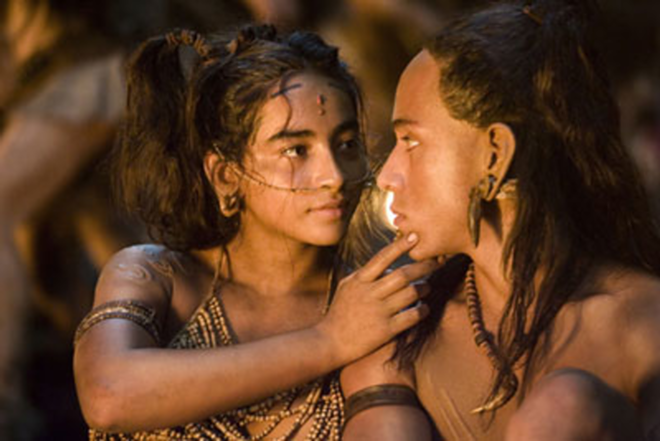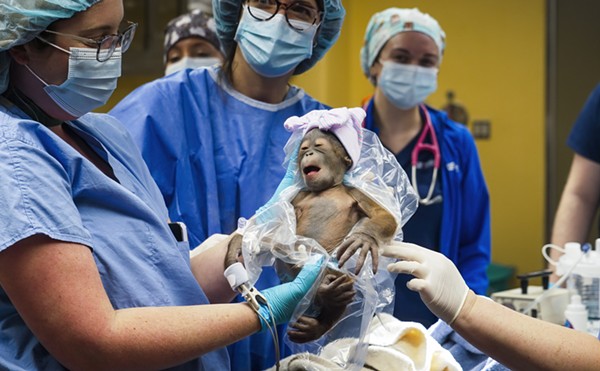
If you can stomach one more sliver of information about Mel Gibson, consider the strange connection between him and Borat mastermind Sacha Baron Cohen. Beyond the fact that both gained a degree of notoriety baiting Jews, gays and women (whether intentionally or not), there's this: Both men seem to instinctively exploit the power of words to enlighten even as they obscure. Specifically, both of these guys are inordinately fond of making movies in languages almost certain to be incomprehensible to their intended audience.
Subtitles are generally provided, of course, but subtitles can only be trusted so far. Of the many subversive pleasures of Borat, not the least are all those wacky asides muttered by Baron Cohen's monumentally clueless and virulently anti-Semitic alter ego — off-the-cuff remarks supposedly spoken in the character's native Kazakhstani, but actually delivered, in one of the decade's better inside jokes, in perfect Hebrew.
As for Gibson, Apocalypto is the director's second movie in a row presented entirely in a language that is either officially dead or on its way to the linguistic graveyard, and that alone could provide cause for alarm. All of the dialogue in Apocalypto is in a Mayan dialect surely unknown to most megaplex-goers, so we can only hope that Gibson isn't pulling a Baron Cohen on us here: translating a line as "The weather is fine," when what's really being said is "Homosexuals are the dogs of hell, and the Jews ate my homework." Given the filmmaker's wildcard status, anything's possible.
I'm still on the fence as to whether Gibson's the biggest bonehead of our time or some kind of coolly calculating genius, but Apocalypto throws a new wrench into the works. For those of you completely over Gibson after his recent tirades and wondering if there might be any possible reason to be interested in yet another foray into subtitled, gore-soaked sadism from this controversial celebrity, I urge you to give Mel another chance.
Although it's just a chase movie at its stripped-down core (think The Most Dangerous Game by way of John Woo's Hard Target), Apocalypto does what it does exceedingly well, keeping the delusions of grandeur to a minimum while managing to show us a few things that we haven't seen before. The film's exotic flourishes are as intoxicating as they are omnipresent, even as Apocalypto plows ahead with the energy and compelling forward momentum of a Mad Max popcorn epic.
Don't look for deeper meanings or historical-cultural context here and you'll probably do just fine. The movie is set during the waning days of the Mayan empire that thrived in Central America through the 15th century, but Apocalypto doesn't pretend to offer any grand insights as to why this great civilization flourished or why it vanished. What we do get are tantalizing fragments of what might have been, a slice of life that begins in a small, jungle village, explodes into the head-spinning chaos and terrible beauty of a full-blown Mayan city, then resolves itself in a final burst of speed and motion, as the protagonist races to elude his murderous pursuers and make it home alive.
The film mixes beauty and savagery from the start, beginning in the lush depths of the rainforest with a group of meticulously scarred and tattooed warriors, and a tapir hunt that ends in the graphic dismemberment of the beast (and the eager consuming of its various raw organs). The sequence culminates with the gobbling up of the animal's testicles — a moment played for laughs and that, along with a practical joke or two, some teasing banter and the ever reliable image of an unpleasant mother-in-law, serves to humanize these fierce Mayan warriors and make them familiar to us.
Don't get too comfortable, though, in this tougher-than-nails but essentially peaceful, pre-industrial paradise. Within the film's first half hour, we get even more elaborately pierced, plugged and tattooed warriors invading the relative calm of the village, and Apocalypto bursts into the first of those extended sequences of raping, pillaging and carnal mutilation of which its director is so fond. The villagers that manage to escape death are bound together by their cruel captors and led on a long march to become slaves and worse in the massive Mayan city that lies beyond the jungle.
That long march provides the meat of the movie, a guided tour through a landscape full of wild and inexplicably strange sights and sounds, culminating in the riot of color and detail that is the Mayan city. The way to the city is fraught with danger, natch, and riddled with the diseased and dying, skeletal wretches drifting through a panorama of hell (convincing enough to make those studio suits want to reconsider axing Gibson's Holocaust project).
And the city, once reached, turns out to be a place unlike any the movies have taken us to before, a marvel of perverse pageantry that might have been imagined by Fellini and choreographed by Leni Riefenstahl. Hierarchies of bizarre humanity line the labyrinthine spaces leading up to the central plaza and its great temple, where holy fools gibber ecstatically about the glory of decay, and head priests rip the still-beating hearts from their human sacrifices before throwing the remains to the roaring crowd.
This is strong stuff and the best filmmaking Gibson has ever done: A mix of triumphant production design and what feels like meticulously researched cultural anthropology married to visionary ethno-sci-fi worthy of Jodorowsky's El Topo, the Mayan city is the visual centerpiece of Gibson's movie.
From there, Apocalypto brings it all home, personalizing its vision through the eyes of one man — the enslaved villager, Jaguar Paw (Rudy Youngblood) — and the mad dash that encompasses the final third of its nearly two-and-a-half hour running time. Jaguar Paw escapes his fate as a human sacrifice and hightails it into the jungle, dealing with a succession of snakes, carnivores, quicksand, treacherous waterfalls and, of course, his savvy and savage human pursuers.
The action is brisk and the violence absolutely brutal (be warned), but Apocalypto's bloodletting rarely feels gratuitous; the world we're presented with here is a hard, violent place, and the aggressions of Apocalypto feel like a natural element in that scheme of things (as opposed to, say, the blatant, bloody sensationalism beefing up the faux spirituality of Passion of the Christ).
Beyond that, the movie's attention to detail is first-rate, its casting is inspired (the performers are mostly non-professionals whose magnificent faces express more than a lifetime's worth of acting classes could supply), and it rarely stops to catch its breath.
Apocalypto is no masterpiece, but it's a more-than-respectable effort from a director who, at his best, produces some of the most visceral moviemaking Hollywood has to offer — no small feat in these blandest of times. Perhaps most important, Apocalypto reminds us that worthwhile art can issue from even the most flawed human beings, and that alone might be worth the price of admission.

















